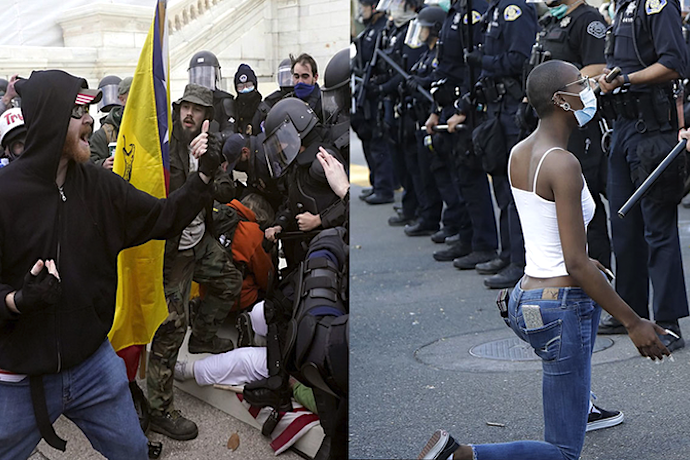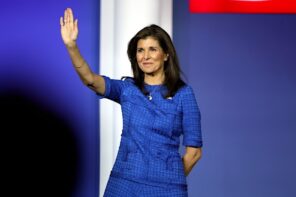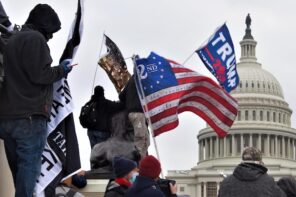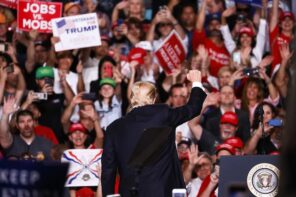“Be there, will be wild!” Trump tweeted at his supporters on December 19, thousands of whom showed up in Washington, DC, several weeks later at their leader’s urging. They climbed walls, waved Trump flags, and literally broke into the chambers of Congress. Trump’s army had orchestrated the breach that the Confederate Army had hoped for during the Civil War.
The response, or lack thereof from law enforcement officials as this act of terrorism unfolded, reveals the true meaning of “law and order” in America. How did a mob force their way into the heart of the nation’s capital and the very halls of democracy?
Some have conjectured that the authorities were taken by surprise and couldn’t mobilize in time to resist such a crowd, but even apart from the videos showing Capitol police taking selfies with and letting protesters into the building, the evidence does not support this.
The president, with help from his supporters in Congress, had been whipping up his followers for two months with fraudulent claims that the election was stolen. He openly called for his supporters to resist all standard procedures for ensuring the smooth transition from one administration to the next. They were even prepared with commemorative T-shirts and hoodies that read: “MAGA Civil War, January 6, 2021.”
I asked these guys if civil war was what they wanted. “Yes” they replied pic.twitter.com/BLopvJP6Ik
— Tess Owen (@misstessowen) January 6, 2021
On the day of the rebellion the president told his followers at a rally to “walk down to the Capitol” in protest of the “egregious assault on democracy.”
And now it’s been revealed that an FBI office in Virginia had sent a report warning of violence to its Washington office, a warning that was, according to the New York Times “passed on to other law enforcement agencies… [though] it was not clear which agencies received it.”
How could the authorities not have known?
Five people have died as a result of the mayhem at the Capitol. So far police have charged about seventy people, mostly for violating curfew and for illegal entry. As many have noted, on social media and elsewhere, this response pales in comparison to the show of force law enforcement demonstrated just a few months ago during the Black Lives Matter protests in the summer of 2020. They stormed the halls of Congress carrying Confederate flags and smiling in pictures, perhaps the most famous of which shows an older white man, Richard Barnett, reclining in a chair in House Speaker Nancy Pelosi’s office, with his feet up on her desk. In a later video he can be seen waving a piece of mail stolen from the Speaker’s desk.
This was the US Capitol during the BLM protests and this is it today. pic.twitter.com/BhpZd6pw8e
— O M (@oliviamunn) January 6, 2021
When Black people and their allies took to the streets to cry out for justice for George Floyd, Breonna Taylor, and Ahmaud Arbery—unarmed Black people killed by police or vigilantes—the police came out with tear gas, batons, armored vehicles, and a readiness to escalate using physical violence.
Even the language was different. Black Lives Matter protesters were “thugs” while the people staging a literal rebellion against democracy were called by the president “great patriots.”
The protests against anti-Black racism happened amid calls by many for “law and order.” This phrase has long been used as a dog whistle to imply that protests against anti-Black racism had to be dealt with swiftly and harshly. It has never been used in the same way to white racial terrorism or crime.
As far back as 1966, political conservatives and others decried the urban uprisings, often in protest of police brutality, as signs of a decaying social order. “Who is responsible for the breakdown of law and order in this country?” asked Richard Nixon in an article for U.S. News & World Report. Nixon ran ads for his presidential campaign that said, “I pledge to you, we shall have order in the United States.”
Even the laws are different when it comes to protests in support of Black civil rights.
In 1967, a state representative from California named Don Mulford proposed a bill to outlaw the open carrying of loaded firearms. He proposed this bill in direct response to the Black Panther Party which had been conducting armed patrols to monitor police interactions with local Black residents to help prevent incidents of police brutality.
On May 2, 1967, in response to the Mulford Bill, members of the Black Panther Party entered the California State Capitol in Sacramento. They were armed, orderly, and Black. Although they had broken no laws, police confiscated their weapons for a time and removed them from the premises. Later that day, one of the Black Panther Party leaders, Bobby Seale, read a statement:
“The Black Panther party for self-defense calls upon the American people in general and the black people in particular to take careful note of the racist California Legislature which is considering legislation aimed at keeping the black people disarmed and powerless at the very same time that racist police agencies throughout the country are intensifying the terror, brutality, murder and repression of black people.”
Then-governor Ronald Reagan was quoted in a newspaper at the time giving a very different message. He said the “invasion” was a “ridiculous way to solve problems that have to be solved among people of good will.” He objected to even the “implied threat weapons might be directed against fellow Americans.” As a result, the Mulford Bill was fast-tracked, and Reagan signed it into law on July 28th, 1967.
Law and order applies only to Black people and those who support their freedom, dignity, and rights. This disproportionate response to Black people who protest for their own lives is part of a long history of attempts to control Black bodies. It’s part of the assumption that Black people inherently pose a threat to law enforcement and must be harshly policed.
But when it comes to white supremacist extremists, their violence, rebelliousness, and brazenness are quintessential pieces of white American culture. The crisis in the Capitol isn’t seen as deserving of a strong show of force because so many of the people empowered to control such terrorism either underestimate its dangers or, worse, are sympathetic to the cause.
The words “law and order” have long been weaponized against racial justice advocates while the illegal and seditious activity of white supremacist extremists gets a pass. When Black Lives Matter protesters are met with military force while armed insurrectionists storm the Capitol with hardly any resistance, you know what “law and order” truly means—the brutalization of Black bodies and the coddling of white terrorists.





